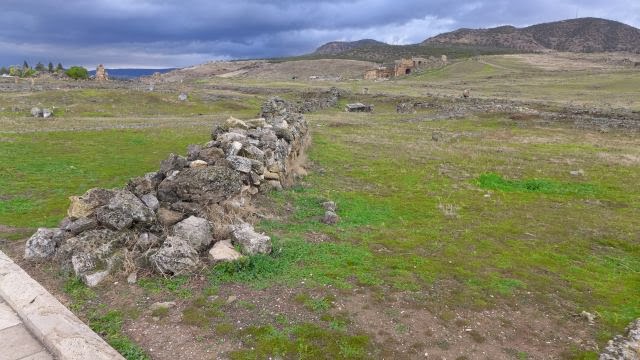Pamukkale - Konya, Turkiye
Wed, 29/1/14
Pamukkale – Konya
Journey today:
Pamukkale - Dinar : 119km (1 hr 25 mins)
Dinar - Dinlenme Tesisleri (Kirazli Bahce): 131km (1 hr 40 mins)
Dinlenme Tesisleri - Konya : 154 km (1 hr 52 mins)
Konya - Sultanhani: 107km (1 hr 20 mins)
Sultanhani - Uygup, Cappadocia region: 138km (1 hr 44 mins)
Total journey: 650km (8 hrs 6 mins)
This is the furthest of our journey in Turkiye
Pamukkale - Dinar : 119km (1 hr 25 mins)
Dinar - Dinlenme Tesisleri (Kirazli Bahce): 131km (1 hr 40 mins)
Dinlenme Tesisleri - Konya : 154 km (1 hr 52 mins)
Konya - Sultanhani: 107km (1 hr 20 mins)
Sultanhani - Uygup, Cappadocia region: 138km (1 hr 44 mins)
Total journey: 650km (8 hrs 6 mins)
This is the furthest of our journey in Turkiye
Pamukkale - Dinar - Konya - Sultanhani - Urgup, Cappadocia
Rise and shine at 5.30am, then we had buffet styled breakfast and check out at 7.30am. Our first destination today was Pamukkale / Hierapolis, a Unesco World Heritage site listed under #485 Hierapolis - Pamukkale which was just about 10 mins from our hotel. Since we arrived after dark yesterday, we only could see the breathtaking view of the white terraced landscape today.
From wikipedia: Pamukkale,
means "cotton castle" in Turkish. Pamukkale's terraces are
made of calcium carbonate which is deposited by the water as a soft
jelly twhich eventually hardens into terraces called travertine. The
hot water spring temperature ranges from 35 °C to 100 °C The
underground volcanic activity causes the hot springs. Pamukkale's size is diminishing with time
 |
| Terraces of Pamukkale |
 |
| Pamukkale pools |
 |
| let's swim! |
Next to the white pool terraces of
Pamukkale lies the ancient ruins of Hierapolis which means “Holy
City”. From Wikipedia: Hierapolis was founded as a thermal spa
early in the 2nd century BC within the sphere of the
Seleucid
Empire. Hierapolis became a healing centre where doctors used the
thermal springs as a treatment for their patients. There is a theatre
in the city which consisted of stacked seating with a capacity of
15,000 and was bisected by a horizontal
corridor. It featured an imperial box.
 |
| Ancient ruins of Hierapolis |
 |
| Hierapolis theatre |
 |
| Antique pool of Hierapolis |
We only spent 1.5 hours here at
Pamukkale-Hierapolis which wasn't enough for me to take photographs.
I didn't manage to go to the theatre as it was a bit further from the
Pamukkale pools. I stopped by the souvenir shop before boarding the
bus to get a fridge magnet for 3TL
Next in the itinerary was Konya to
visit the Mevlana museum. On the way we stopped by a small town, Dinar to enjoy the
home made yogurt from goat milk. The yogurt was creamy and topped
with honey and opium poppy seeds. I didn't get high though from the
opium.
 |
| Dinar yogurt. That's the poppy seed! |
We stopped again next, this time for
lunch at Kirazlibahce of yummy grilled chicken wings and delicious soup. One thing for sure, for all our meals, we would be served appetizer of
salad, soup and bread; main dish of meat (chicken or beef) with rice
and dessert of fruits.
 |
| yummy grilled chicken wings w butter rice |
 |
| Kirazlibahce |
We had to rush to Konya to catch the
opening time of the Mevlana museum. Finally we arrived at Konya at
3.40pm. From Wikipedia: The Mevlâna
Museum is the mausoleum of Jalal
ad-Din Muhammad Rumi, a Sufi
mystic also known as Mevlâna or Rumi. It was also the dervish
lodge (tekke) of the Mevlevi
order, better known as the whirling dervishes. The mausoleum and
dervish lodge was converted into a museum in 1926. There is a
marble-paved courtyard with a sadirvan (washing fountain) in the
middle. The kitchen of the dervishes (Matbah) was also used
for educating the dervishes, teaching them the Sema.
The mausoleum doors are decorated with
Seljuk
motifs and a Persian text from mollah
Abdurrahman Cami dating from 1492. It leads into the small Tilavet
Room (Tilavet Odası) decorated with rare and precious Ottoman
calligraphy in the sülüs,
nesih, and talik
styles. In this room the Koran was continuously recited and chanted
before the mausoleum was turned into a museum. Photography of the tombs is not allowed.
According to Burak, Konya is the most religious (Islamic) city in Turkiye. All the restaurants are closed during the day in Ramadhan. At other cities, the restaurants are opened.
 | ||||||
| Konya museum |
 |
| Sufi |
 |
| Sufi at the kitchen |
After the museum, we stopped for solat
at Haci Veyis Camii nearby and then proceeded to visit the Sultanhani
Caravanserai which was about 1hr 20mins away. It was already dark
when we arrived at Sultanhani and the caravanserai has already been
closed. We had to wait for about 15 minutes for the gatekeeper to come and open the door for us.
Caravanserai was a roadside inn where traders traversing the
Silk Road / long distance travellers could rest and recover from the
day's journey. There was also a courtyard to place animals such as
camels and carriages.
 |
| Haci Veyis Camii |
 |
| ablution place at Haci Veyis Camii |
 | |
| courtyard of Sultanhani caravanserai |
 |
| stairways |
 | |
| carriages |
About 2 hours away from Sultanhani was
our final destination for today – the region of Cappadocia. We
would be staying at the 5 star Dinler hotel in Uygup which was just a
few minutes away from our hot air balloon take off point. We arrived
at the hotel at 8.45pm Dinner was served buffet style, but the dishes
were only so-so. Perhaps the tiring journey spoiled my appetite.
After dinner, we went back to our rooms for rest. Tomorrow would
start very early at 5.50am for our hot air balloon ride.
 |
| Dinler room |
Labels: Travelogue













0 Comments:
Post a Comment
<< Home